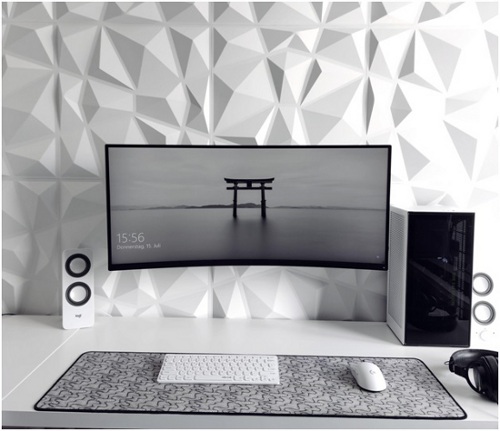Display technologies have come a long way since the first cathode ray tube (CRT) monitors were introduced. Each gaming monitor display technology has pros and cons. We’ll examine LCD, OLED, and Quantum Dot display technologies and their gaming applicability in this article.


Liquid Crystal Display (LCD)
Today, most gaming monitors use LCD displays. These displays employ a backlight to illuminate a layer of liquid crystals, which may block or pass light to generate an image. LCD monitors are a budget-friendly option for gamers. Gaming requires fast response times, which LCD monitors provide.
How Do Lcds Work?
Millions of pixels make a display. 4K displays have 3840 x2160 or 4096 x 2160 pixels, which determines their quality. A pixel has three subpixels—red, blue, and green—called RGB. A distinct colour can be formed when the subpixels in a pixel change colour combinations. When all of the pixels on a display work together, it may produce millions of different colors. A picture is generated when the pixels are rapidly switched on and off.
LCD Drawbacks
However, LCD technology has drawbacks. Limited viewing angles are one of LCD monitors’ biggest limitations. The image on an LCD might be distorted or washed out if viewed at an angle. LCD monitors also lack deep blacks like OLED and Quantum Dot displays. Some games have trouble distinguishing black colours in gloomy scenes due to this.
What is IPS?
In-plane switching (IPS) is a panel technology for LCD monitors. Compared to TN and VA panels, IPS monitors provide better image quality and viewing angles. For individuals who do more than just gaming, IPS monitors provide the highest colour accuracy. As you can assume, IPS monitors are the most expensive panel technology due to their additional benefits.
OLED (Organic Light Emitting Diode)
OLED monitors use organic compounds that emit light when an electric current is applied to them. This technology allows OLED monitors to achieve perfect blacks and infinite contrast ratios, which can make games look more vivid and lifelike. OLED monitors feature wide viewing angles. Thus image quality is stable from any angle.
OLED Drawbacks
OLED technology has image retention and burn-in issues. A ghost image appears when a static image is presented on the screen for a long time. When a static image is viewed for a long time, the pixels deteriorate and permanently retain the image, creating burn-in.
Despite these limitations, gamers who desire the finest image quality use, OLED monitors. OLED monitors cost more than LCD monitors. Thus budget-conscious gamers may not want them.
Quantum Dot
The Quantum Dot display technology is new. QD monitors produce colours with semiconductor nanocrystals. When an electric current is supplied, these nanocrystals emit light at specified wavelengths, producing more accurate and bright colours than LCD screens.
Quantum Dot technology’s broader colour spectrum makes games more realistic and engaging. QD monitors are bright enough for bright gaming settings.
Quantum Dot Drawbacks
Quantum Dot technology’s “blooming” is a major downside. Bright things on the screen spill into surrounding areas, generating blooming. It can be distracting in some games, but not usually. Quantum Dot displays offer the finest image quality without OLED’s limitations for games. QD displays cost more than LCD monitors. Therefore budget gamers may not prefer them.
LED Technology (Light Emitting Diode)
LED displays are nearly identical to LCD displays, with the key distinction being the type of backlight utilized. Instead of traditional fluorescent tubes, LED displays use a sequence of light-emitting diodes (LEDs) to illuminate the display. LED displays outperform LCD displays in terms of energy efficiency, color accuracy, and lifetime.
LED displays are especially popular for gaming since they have faster response times and higher contrast ratios than typical LCD displays. They are perfect for fast-paced games due to their faster response times, and their increased contrast ratios make visuals appear more bright and lifelike.
MicroLED
A revolutionary display technology, microLED offers exceptional brightness, colour accuracy, and low input lag. Modular microLED displays can be customized to different sizes and shapes. However, microLED monitors are pricey, making them less accessible to gamers.
Factors To Consider When Choosing A Display Technology For Gaming
Consider resolution, panel type, and size when picking a game display technology. 4K and ultrawide resolutions can provide more immersive gaming experiences, but they may require more powerful technology. IPS and VA panels provide better colour accuracy and contrast ratios than TN screens but longer response times and more input lag. Larger screens have greater screen real estate but cost more and take up more space.
In addition to display technology, gamers should consider features like variable refresh rate (VRR) and HDR (High Dynamic Range). AMD FreeSync and NVIDIA G-Sync decrease screen tearing and stuttering for better gameplay. HDR enhances image contrast and colour, making it more realistic.
Conclusion
In conclusion, there are several display technologies available for gaming monitors, each with its own set of strengths and weaknesses. Thanks to their fast response times, LCD monitors are a popular choice for gamers on a budget. OLED monitors offer the best possible image quality, with perfect blacks and infinite contrast ratios. However, they can suffer from image retention and burn.
















